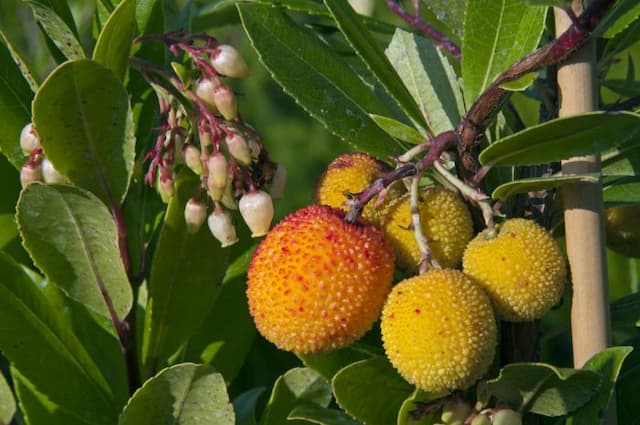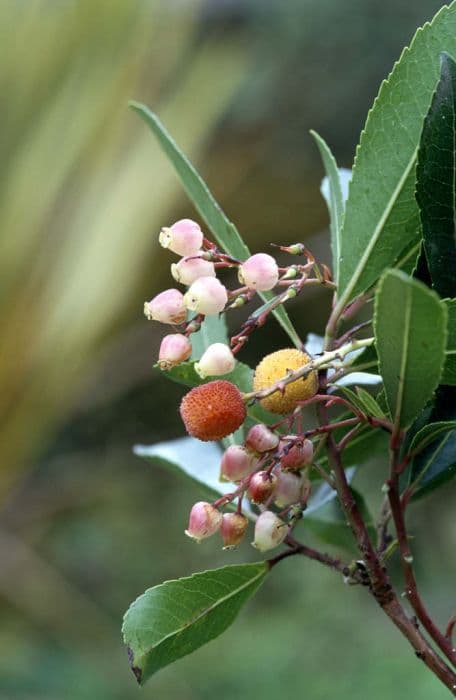Rainbow Leucothoe Leucothoe Scarletta = 'Zeblid'
![dog hobble [Scarletta]](/_next/image?url=https%3A%2F%2Fplants-admin.emdemapps.com%2Fimages%2Fplants%2F%2Fimages%2F604b5d3586ffd.png&w=3840&q=75)
ABOUT
Leucothoe Scarletta, commonly known as Leucothoe or Rainbow Fetterbush, is a visually striking plant with a number of appealing features. It displays elongated, lance-shaped leaves, which create a dense and bushy appearance. The foliage is particularly noteworthy for its changing colors throughout the seasons. In spring, the new growth is a fiery red that eventually matures into a deep green as the season progresses. Come fall, the leaves transition again, showcasing shades of rich burgundy and purple, providing a vibrant splash of color in garden spaces. Adding to its ornamental appeal, the Leucothoe Scarletta produces delicate clusters of small, bell-shaped flowers in the late spring to early summer. These blooms hang from arched stems, contrasting with the dark, glossy leaves. The flowers are typically white with a soft blush of pink, adding a graceful and subtle floral display to the bush. The Rainbow Fetterbush's evergreen nature ensures that it maintains its lush appearance year-round, only enhanced by the seasonal transformations of its leaves. Its branches are somewhat arching, contributing to the overall texture and fullness of the plant. Thanks to its elegant form and changing color palette, Leucothoe Scarletta makes a versatile addition to any garden, suitable for mixed borders, as an understory plant, or even in a mass planting for a dramatic effect.
About this plant
 Names
NamesFamily
Ericaceae.
Synonyms
Scarletta Fetterbush, Drooping Leucothoe, Swamp Doghobble.
Common names
Leucothoe fontanesiana 'Zeblid'
 Toxicity
ToxicityTo humans
Fetterbush (Leucothoe Scarletta 'Zeblid') is considered poisonous to humans. Ingesting parts of this plant can lead to symptoms including vomiting, diarrhea, and lethargy. As with many poisonous plants, the severity of the symptoms can vary based on the amount consumed and the sensitivity of the individual. It's important to keep this plant out of the reach of children who might be tempted to eat its leaves or berries.
To pets
Fetterbush (Leucothoe Scarletta 'Zeblid') is also toxic to pets. If a pet ingests part of this plant, they might exhibit signs of poisoning such as vomiting, diarrhea, weakness, and possibly seizures in severe cases. As with human poisoning, these symptoms can be more or less severe depending on the amount ingested and the sensitivity of the particular animal. It's crucial to prevent pets from accessing this plant to avoid potential poisoning.
 Characteristics
CharacteristicsLife cycle
Perennials
Foliage type
Evergreen
Color of leaves
Varies
Flower color
White
Height
2-4 feet (0.6-1.2 meters)
Spread
2-4 feet (0.6-1.2 meters)
Plant type
Shrub
Hardiness zones
5
Native area
Southeastern United States
Benefits
 General Benefits
General Benefits- Ornamental Appeal: The Leucothoe Scarletta 'Zeblid', commonly known as Drooping Leucothoe, features attractive burgundy-red foliage that provides visual interest throughout the year, enhancing garden aesthetics.
- Low Maintenance: This plant is relatively easy to care for, requiring minimal pruning and maintenance, making it suitable for gardeners of all skill levels.
- Shade Tolerance: Drooping Leucothoe thrives in partial to full shade, making it an excellent choice for shaded gardens where other plants may struggle.
- Wildlife Habitat: The dense foliage of Drooping Leucothoe offers shelter and nesting sites for birds and other small wildlife, promoting biodiversity.
- Soil Erosion Control: The spreading growth habit of this plant helps stabilize the soil, preventing erosion on slopes and in other vulnerable areas.
- Seasonal Interest: Drooping Leucothoe's leaves change color with the seasons, from red in spring to deep green in summer, and bronze-purple in fall, providing year-round interest.
- Drought Tolerance: Once established, Drooping Leucothoe can tolerate periods of drought, making it suitable for xeriscaping and low-water gardens.
 Medical Properties
Medical PropertiesThis plant is not used for medical purposes.
 Air-purifying Qualities
Air-purifying QualitiesThis plant is not specifically known for air purifying qualities.
 Other Uses
Other Uses- As a natural dye: Leucothoe Scarletta can be used in dyeing textiles, offering a range of colors depending on the mordant used.
- Insect repellant: Some homeowners plant Leucothoe Scarletta as a belief that it may help repel certain insects due to its aromatic foliage.
- Craft material: The stems and foliage can be used in floral arrangements and wreaths for their attractive color and texture.
- Photography: The vibrant red foliage provides a stunning backdrop for photographers, especially during autumn.
- Artistic inspiration: Artists may use Leucothoe Scarletta as a subject for paintings or drawings due to its unique color and form.
- Erosion control: Its dense growth habit helps stabilize soil in sloped gardens or landscapes prone to erosion.
- Aquarium use: When properly treated, stems of Leucothoe Scarletta can be used as decoration in aquariums.
- Theme gardens: The plant is utilized in 'gothic' or 'vampire' themed gardens for its dark, brooding foliage.
- Privacy screens: The thick foliage of Leucothoe Scarletta can be used to create privacy when planted in hedge form.
- Wildlife habitat: While not its primary use, the dense foliage can provide shelter for small wildlife and birds.
Interesting Facts
 Feng Shui
Feng ShuiThe plant Leucothoe is not used in Feng Shui practice.
 Zodiac Sign Compitability
Zodiac Sign CompitabilityThe plant Leucothoe is not used in astrology practice.
 Plant Symbolism
Plant Symbolism- Transformation: With its foliage transitioning from burgundy in the spring to dark green in summer, and then to purple or reddish hues in fall, the Leucothoe Scarletta represents change and adaptability.
- Protection: As an evergreen shrub, it symbolizes shelter and safety throughout the year, offering protection against natural elements.
- Rejuvenation: Its ability to bounce back from pruning and harsh conditions signifies renewal, resilience, and the ability to thrive in adversity.
- Unity: The dense, clustered growth of the shrub symbolizes closeness, community, and the strength of individuals coming together.
 Water
WaterThe Scarletta Leucothoe, also known as Doghobble, prefers consistently moist soil and should be watered thoroughly when the top inch of soil feels dry to the touch. This plant will usually require watering about once a week, but this can vary depending on the climate and season. During the hotter periods, it may need watering two to three times a week, and during colder months, less frequent watering is necessary. When watering, aim to provide approximately one gallon of water per plant, ensuring even soil moisture without waterlogging.
 Light
LightThe Scarletta Leucothoe thrives in partial shade to full shade conditions. It is best positioned in a spot where it can receive filtered sunlight or morning sun with protection from the harsh afternoon sun. This plant should not be placed in intense, direct sunlight as this can damage the foliage, preferring instead dappled light or a north-facing exposure for optimal growth.
 Temperature
TemperatureThe Doghobble prefers a temperature range between 60 and 80 degrees Fahrenheit but can tolerate temperatures as low as 0 degrees Fahrenheit once established. It's recommended to protect the plant from extreme cold by mulching its base in fall. The ideal temperature conditions for promoting good growth are around the 70-degree Fahrenheit mark.
 Pruning
PruningPrune Doghobble in late winter or early spring to maintain its shape and encourage bushier growth. Remove any dead or damaged branches and trim back any overgrowth to keep the plant looking tidy. Pruning is not required frequently, but an annual trim can benefit the plant's health and appearance. The best time for a more thorough pruning is after the plant has bloomed to avoid cutting off next year's flower buds.
 Cleaning
CleaningAs needed
 Soil
SoilDrooping Leucothoe 'Zeblid' prefers acidic soil with a pH between 4.5-6.0. A well-draining soil mix with peat moss, pine bark, and perlite is ideal to promote healthy root growth and to ensure proper drainage, which is crucial for this plant's health.
 Repotting
RepottingDrooping Leucothoe 'Zeblid' should be repotted every 2-3 years or when it becomes root-bound. The best time to repot is in the early spring before new growth starts, ensuring minimal stress to the plant.
 Humidity & Misting
Humidity & MistingDrooping Leucothoe 'Zeblid' thrives in moderate to high humidity levels, ideally around 50-60%. If grown indoors, it may benefit from the use of a humidity tray or room humidifier to maintain sufficient moisture in the air.
 Suitable locations
Suitable locationsIndoor
Place in well-lit area away from direct sun; keep soil moist.
Outdoor
Partial shade location; protect from harsh sun and wind.
Hardiness zone
5-8 USDA
 Life cycle
Life cycleLeucothoe Scarletta ('Zeblid'), commonly known as Drooping Leucothoe, begins its life as a seed that germinates in spring to early summer under the right conditions of moisture and temperature. It then produces a young seedling with a small rosette of leaves that will develop into a mature plant over several years, with stems that can reach up to 3-4 feet tall. The plant produces evergreen foliage which changes color throughout the seasons, from red-bronze in spring to dark green in summer, and then to purple in the fall and winter. In late spring to early summer, small white or pale pink, bell-shaped flowers bloom in clusters, providing ornamentation and potential pollination by attracting bees and butterflies. After fertilization, the flowers will develop into tiny capsules containing seeds that can be dispersed to start new plants. Finally, as a perennial shrub, it enters a period of dormancy in winter, during which growth slows down, only to begin again the following spring.
 Propogation
PropogationPropogation time
Late Spring-Early Summer
Leucothoe Scarletta 'Zeblid', commonly known as the Drooping Leucothoe or Fetterbush, is most effectively propagated during late winter or early spring before new growth begins. The most popular method of propagation for this plant is semi-hardwood cuttings. To propagate, a gardener would take a cutting of about 4 to 6 inches (10 to 15 cm) from a healthy, semi-hardwood portion of the plant, typically from the mid to late summer growth. The leaves on the lower half of the cutting should be removed, and the base of the cutting treated with a rooting hormone to speed up the rooting process. It is then inserted into a planting medium that is kept moist until roots develop, which generally takes several weeks. During this time, the cutting should be kept in indirect light and at a consistent temperature to promote rooting. After the roots have established, the new Fetterbush plant can be transplanted to its permanent location.









